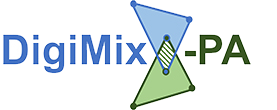Overview of available precision farming technologies
Various technologies are available for precision agriculture, which will be applied in DigiMix-PA.
- Soil sensors enable the high-resolution mapping of soil properties and the characterization of the variability of soil properties within a field. This knowledge is crucial for demand-oriented nutrient and lime fertilization.
- Remote sensing systems such as drones or satellites record high-resolution biomass properties. This data is used to estimate yield potential, identify management zones and develop fertilization strategies.
- Vehicle-based N-sensors measure the nitrogen supply to the plants. The N fertilizer requirement can be derived on the basis of this data.
- Sensors on slurry tanks use near-infrared spectroscopy to measure the nutrient composition of the slurry in real time during filling. This enables precise and demand-oriented application.
- GPS-supported application techniques ensure that mineral fertilizer is applied exactly where it is needed. This increases the efficiency of fertilization.
- Stationary sensors and sensor networks continuously monitor soil and climate properties and provide information for better planning of cultivation measures.
- Yield mapping systems document yields with great precision. This information is essential for differentiated economic analysis and optimization.


